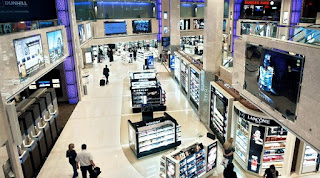Expanding end user
segments including cosmetics, packaged food industry, pharmaceuticals, paints,
pesticides, distillery products, introduction of colour variants in corrugated
box and rising number of manufacturers has pushed China corrugated box market
forward during the review period.
The report titled “China
Corrugated Box Market Outlook to 2022 - By End Users
(Electronics and Consumer Appliances, Food and Beverage, Beauty and Personal
Care, Others), By Wall Type (Single Walled, Double Walled, Triple Walled), by
Colored and Non Colored Boxes” by Ken Research suggested a growth at
a CAGR of close to 9% in China corrugated box market by 2022.
The sale of corrugated box has increased registering an
annual growth rate of close to 10% in 2017. The corrugated box not only caters
to the packaging needs of the end user but also protects the environment as its
products are 100% eco-friendly. Factors such as increasing demand from fresh
food and beverages, home & personal products, electronic goods industries,
logistics application, increasing consumer awareness towards sustainable
packaging and growth of the E-commerce industry have propelled the growth of
the Chinese corrugated boxes. During the period 2012-2014, the production of
corrugated boxes increased by 10 million tons. The period saw an unprecedented
level of growth from 2013-2014 when the production of corrugated boxes grew at
a double digit growth rate. China’s economic slow-down affecting demand from
the downstream industries, fluctuation in prices and tightening environmental
regulation forced many small players to shut down their operations. Environmental
concerns have been taken during the period such as developments in lightweight
boxes and resource-effectiveness.
The period between 2016 and 2017 witnessed huge fluctuation
in the prices of the corrugated boxboard paper prices. The price of the
corrugated boxboard paper rose from RMB 4,810/ton in 2016 to RMB 5,690/ton in
2017. The price fluctuation trend is expected to be continued in 2018 because
of the China’s imposed ban on the import of waste paper, which is an essential
ingredient in the manufacturing of corrugated board, from western nations. The
industry introduced new heavyweight products such as billerud flute
semi-chemical fluting. Primarily, targeted at replacing wooden packaging, this
product is also able to replace double-walled board with an overall lighter
weight single wall substitute. These factors have together contributed in the
development of the market.
Products
Covered:
By type of box (single walled, double walled and triple walled), by end
user (FMCG, Beauty and Personal, Electronics & Appliances and Others), by
Type (Color and non colored) and by type of players (Organized and Unorganized)
Companies
Covered:
Xiamen Hexing, MYS Group, Rengo, Shanying, Bingxin, Yeun Foong Yu,
Pacific Millennium and Shengda Group
For more
information on the research report, refer to below link:
Related Reports:
Contact Us:
Ken Research
Ankur Gupta, Head Marketing & Communications
Sales@kenresearch.com
+91-9015378249
Ken Research
Ankur Gupta, Head Marketing & Communications
Sales@kenresearch.com
+91-9015378249








